I know musicians that are so adamant about exclusively playing their own songs that they wouldn't get caught dead on stage with a "cover" song in their portfolio.
I have other friends that play in bands that play nothing but "cover" tunes. They enjoy bringing familiar songs to life for a live crowd and some get paid well for it.
Now that I no longer do long distance touring, I write a lot of original songs to pitch to publishers and artists, but also play with various local and regional bands that predominately play cover songs. Most musicians I know fall into this "little bit of both" category.
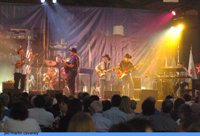 Although it is an admirable goal to pursue strictly original material, there are a number of benefits to learning cover songs that should not be neglected.
Although it is an admirable goal to pursue strictly original material, there are a number of benefits to learning cover songs that should not be neglected.If we, as humans, are a "sum of our experiences", then we, as musicians, are a sum of our "musical experiences". Everything that we have ever played, everything that we have ever heard, all the little bits and pieces, and all the full length scores - are all rolled up together into what makes us each unique as individual musicians.
One could then conclude that, in order to become a better songwriter and broader musician, you should "learn more cover songs".
Although that may be contrary to a songwriting "purist", it stands to reason that even the staunchest supporter of the "original material only" path, had listened to, and emulated, artists that inspired them in the past.
And possibly without knowing it, those "cover" songs have at least had a subconscious affect on their own original music.
Learning cover songs is a great exercise in expanding your musical vocabulary. The things you learn from cover songs have a way of filtering through and becoming part of your style.
My early days of learning to play lead guitar were spent over a turntable "stealing licks" from Jimi Hendrix, Santana, Jeff Beck, Robin Trower, Jimmy Page and Clapton. Those early influences still have a big impact on my playing style, even decades later.
 There are some neat things that can happen while learning and dissecting cover songs. The experience of finally nailing a difficult lick, the satisfaction of figuring out an inconspicuous chord, the discovery of a new chord progression that you had not considered before - there are many "aha" moments when learning cover songs that would have been missed otherwise.
There are some neat things that can happen while learning and dissecting cover songs. The experience of finally nailing a difficult lick, the satisfaction of figuring out an inconspicuous chord, the discovery of a new chord progression that you had not considered before - there are many "aha" moments when learning cover songs that would have been missed otherwise.And all those moments make a consious or unconsious contribution to who you are and who you become musically.
Often times, new guitar players shy away from attempting to learn cover songs. There is a thought that songs on a recording are somehow beyond their reach. But the truth is that, once a guitarist has the basics under their belt, they can discover that many of the songs in popular music that they aspire to learn are actually comprised of chord progressions and patterns that they already know or are familiar with.
 It is through this discovery process that a new guitar player can begin to truly expand their horizons and begin to progress as musicians. In our Beginner Guitar Lessons course we have even dedicated a section to introducing tips and techniques that the new guitar player can take to become proficient at learning cover songs for themselves.
It is through this discovery process that a new guitar player can begin to truly expand their horizons and begin to progress as musicians. In our Beginner Guitar Lessons course we have even dedicated a section to introducing tips and techniques that the new guitar player can take to become proficient at learning cover songs for themselves.So regardless of which path you ultimately end up taking, whether it's the pure original songwriting route, the cover song route, or a combination thereof - keep in mind that spending the time and effort to learn cover songs is a healthy habit to get into and that the effort will pay off in dividends to you musically for as long as you play guitar.
Please do not hesitate to contact us with any questions!

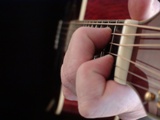
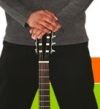 There is such a thing, however, as "too much new information". Take new material in sips, not gulps. Give smaller pieces time to digest before trying to cram too much in there. You will make a lot more progress on the guitar by letting small pieces of new information become slowly ingrained into your playing style, than trying to shove it all down at once.
There is such a thing, however, as "too much new information". Take new material in sips, not gulps. Give smaller pieces time to digest before trying to cram too much in there. You will make a lot more progress on the guitar by letting small pieces of new information become slowly ingrained into your playing style, than trying to shove it all down at once. Unfortunately that's not always the case and may not shake well with the rest of the family! One solution is to try and agree on a dedicated space, somewhere in the house, that you can go to for practicing.
Unfortunately that's not always the case and may not shake well with the rest of the family! One solution is to try and agree on a dedicated space, somewhere in the house, that you can go to for practicing. Try to keep all these things close to your guitar "workstation" so that you don't have to interrupt your practice time chasing them down.
Try to keep all these things close to your guitar "workstation" so that you don't have to interrupt your practice time chasing them down.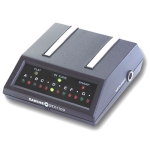
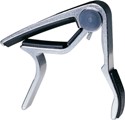
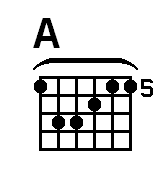

 5th fret. If, as in the previous example, you clamped a capo on the 5th fret in place of using the 1st finger as a barre, you could then play the "D" chord using the same fingering as you would an "A" chord in the open position.
5th fret. If, as in the previous example, you clamped a capo on the 5th fret in place of using the 1st finger as a barre, you could then play the "D" chord using the same fingering as you would an "A" chord in the open position. will allow you to change the "voicing" of a chord. An "E" chord played by barring the 7th fret will have a different sound than an "E" chord played in the open position, even though they are the same chord.
will allow you to change the "voicing" of a chord. An "E" chord played by barring the 7th fret will have a different sound than an "E" chord played in the open position, even though they are the same chord. Capos come in all shapes and sizes and finding the one that works best for you may simply be a matter of trial and error. There are capos made specifically for the acoustic guitar, electric guitar, classical guitar, mandolin, banjo and more.
Capos come in all shapes and sizes and finding the one that works best for you may simply be a matter of trial and error. There are capos made specifically for the acoustic guitar, electric guitar, classical guitar, mandolin, banjo and more.
 We also have some
We also have some  Irregardless of which path you ultimately take, if you have had a dream of "one day" learning how to play the guitar, then resolve, right now, to make "one day"...TODAY!
Irregardless of which path you ultimately take, if you have had a dream of "one day" learning how to play the guitar, then resolve, right now, to make "one day"...TODAY!